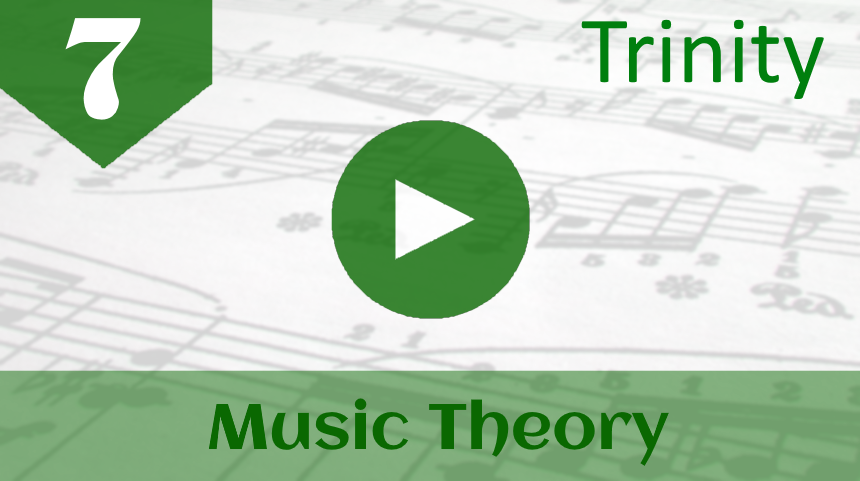Welcome to the Trinity Grade 7 Music Theory Start Page!
On this page you can find the syllabus information, and links to the free and paid Trinity Grade 7 Music Theory lessons available on this site.
You will find a large number of free lessons on this website, or get the full Trinity Grade 7 Music Theory course in your preferred format:
Trinity Grade 7 Free Music Theory Lessons
- 2/8 and 4/8 Time
- Irregular Tuplets
- Tierce de Picardie
- The Cadential 6/4
- Secondary 7ths
- Inverted Cadences
- Pivot Chords
- Prevailing Key
- Direct Modulation
- The Whole Tone Scale
- Using Decoration Notes
- Suspensions
- Analysing Harmony with Decoration Notes
- Arpeggio 6/4 (Alberti Bass)
- Harmonic Sequence with Suspensions
- The Classical Era
Join the MyMusicTheory
Trinity Grade 7 Music Theory Video Course!
- Video lessons covering the complete Trinity grade 7 syllabus
- PDF download including full explanations, exercises, practice test and answers
- Support via email
- Instant access
- No expiry date on the course

Trinity Grade 7 Syllabus
Rhythm and Form
- Irregular rhythmic groupings (e.g. quintuplets, 5:4)
- Unusual time signatures — 9/4, 12/4, 2/8, 4/8, 6/16, 9/16, 12/16 and 16/32
- Notational shorthand
- Rondo and sonata rondo forms
- Coda
- Scherzo and trio
- Sonata form
- Sonatina
- The number and type of movements likely to be found in Classical sonatas, string quartets and symphonies — definitions for each as defined in the workbook
- 12-bar blues
Composers and General Knowledge
Classical period as defined in the workbook
Layout of Classical scores (for orchestra and string quartet) as defined in the workbook
Blues style as defined in the workbook
Composers of particular relevance to this grade are those writing in the Classical period (approximately 1750–1830), e.g. the early works of Beethoven, and works by J Haydn and W A Mozart
Pitch
- Transferring a short extract from close to open score for string quartet, or vice versa
- Recognising and writing all pentatonic major, pentatonic minor, and blues scales
- Recognising and writing Dorian mode scales starting on C, D, F or G
- Identifying an extract written using Dorian mode
- Recognising and writing whole-tone scales
- Writing an 8-bar melody using notes from the major, minor, pentatonic major, pentatonic minor, blues or whole-tone scales or using notes from the Aeolian or Dorian mode
- Identifying modulation turning points through pivot notes, pivot chords and diminished 7th or dominant 7th chords
- Recognising and writing secondary 7ths
- Recognising and writing pre-cadential chord progressions
- Recognising and writing suspensions in a harmonic sequence
- Labelling the chords of a phrase of a chorale/hymn in Roman numerals and chord symbols, and completing it with an appropriate 3-chord progression (bass line given)
- Recognising and writing Tierce de Picardie and inverted cadences – including ivb–V (Phrygian cadence)
- Transposing a simple 12-bar blues chord progression (I I I I IV IV I I V IV I V) and writing an accompaniment using it in piano style (block chords or vamping)
- Recognising Alberti bass and other features in Classical piano/string composition
- Inversion of pedal points and melodies
- Transposing a melody for any transposing instrument for the grade (transposing intervals to be known include those for Grade 6 and also treble recorder, clarinet in A, soprano saxophone in Bb, baritone saxophone in Eb, tenor horn in Eb), also understanding the way Baroque/Classical composers notated music for brass/timpani in orchestral scores
- Ranges of timpani, tenor horn in Eb, trombone (tenor and bass), as defined in the workbook
- Musical terms and symbols
Download the complete Trinity Music Theory Syllabus here.

